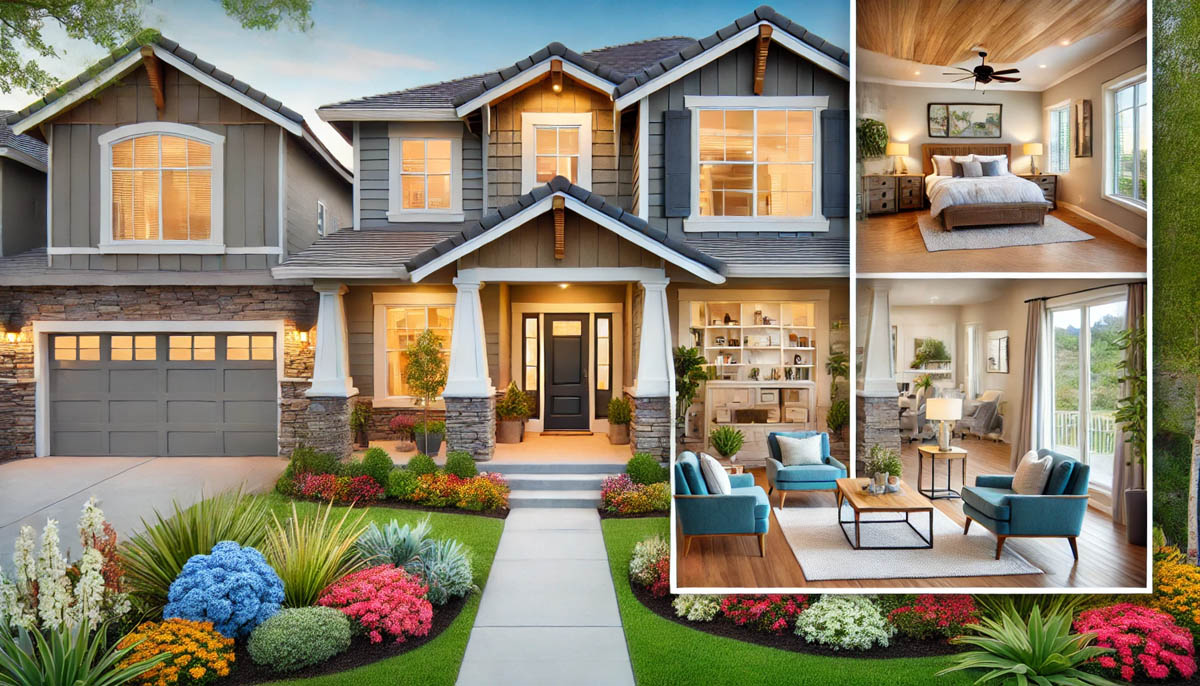Preparing Your Minden Home for Sale: Staging and Presentation Tips


elling a home in Minden, Nevada, involves more than just listing it on the market. To attract potential buyers and secure a favorable sale, preparing your Minden home for sale with proper staging and presentation is crucial. This comprehensive guide provides expert tips on how to prepare your Minden home for sale, focusing on staging techniques, enhancing curb appeal, and creating a welcoming interior environment.
Understanding the Importance of Staging
Staging is the process of preparing a home to make it appealing to the highest number of potential buyers. The goal is to help buyers envision themselves living in the space, which can lead to a quicker sale at a higher price. According to the National Association of Realtors (NAR), staged homes sell 88% faster and for 20% more than non-staged homes.
Enhancing Curb Appeal
The first impression of your home is crucial. Potential buyers often make up their minds about a property within the first few seconds of seeing it. Enhancing curb appeal can significantly impact a buyer’s interest.
1. Landscaping
- Maintain the Lawn: Regularly mow the lawn, trim the edges, and remove any weeds. A well-maintained lawn indicates that the home has been cared for.
- Add Color with Flowers: Planting seasonal flowers in beds or pots can add vibrant color to your garden and create a welcoming atmosphere.
- Trim Bushes and Trees: Overgrown bushes and trees can make a property look neglected. Trim them back to keep the garden looking neat and tidy.
- Clean Walkways and Driveways: Power wash walkways, driveways, and patios to remove dirt, stains, and debris.
2. Exterior Upkeep
- Repaint the Front Door: A fresh coat of paint on the front door can make a significant difference. Choose a color that complements the overall exterior.
- Update House Numbers: Ensure that house numbers are visible and stylish. This small detail can enhance the home’s appearance.
- Clean Windows and Gutters: Clean windows allow more light into the home, making it appear brighter and more inviting. Clearing gutters prevents water damage and shows the home is well-maintained.
- Fix Any Visible Damage: Repair any cracks in the driveway, broken roof tiles, or damaged siding. These issues can deter buyers and lower the home’s perceived value.
Creating a Welcoming Interior
Once potential buyers step inside, the interior should continue to impress. Focus on decluttering, depersonalizing, and making strategic improvements to showcase the home’s best features.
1. Declutter and Depersonalize
- Remove Personal Items: Take down family photos, personal collections, and other items that may distract buyers from seeing the home as their own.
- Minimize Clutter: Clear countertops, shelves, and tables of unnecessary items. Use storage bins or rent a storage unit if needed.
- Organize Closets and Storage Spaces: Neatly organized closets and storage areas give the impression of ample space and functionality.
2. Deep Clean
- Clean Every Surface: Pay attention to details such as baseboards, light fixtures, and windowsills. A spotless home feels more inviting.
- Address Odors: Ensure the home smells fresh by using air purifiers, scented candles, or fresh flowers. Avoid strong artificial fragrances that may be off-putting.
- Steam Clean Carpets and Upholstery: Professionally clean carpets and upholstery to remove stains and odors.
3. Neutralize the Decor
- Paint Walls in Neutral Colors: Neutral colors such as beige, gray, or soft white appeal to a broader audience and make spaces feel larger.
- Remove Bold Decorations: Replace bold or eccentric decor with more subdued, universally appealing options.
- Add Simple Accents: Use throw pillows, blankets, and artwork in neutral tones to add warmth without overwhelming the space.
Strategic Staging Techniques
Effective staging highlights the home’s strengths and downplays any weaknesses. Focus on creating a cohesive and inviting atmosphere in each room.
1. Living Room
- Arrange Furniture for Flow: Arrange furniture to create conversational areas and ensure there is a clear path through the room.
- Use Light to Your Advantage: Open curtains and blinds to let in natural light. Add lamps in darker corners to brighten the space.
- Add Inviting Elements: Use soft throws, cushions, and a few tasteful accessories to make the room feel cozy and welcoming.
2. Kitchen
- Clear Countertops: Keep countertops as clear as possible, showcasing the available workspace.
- Organize Cabinets and Pantry: Neatly arrange items in cabinets and the pantry to demonstrate ample storage space.
- Add Fresh Elements: Place a bowl of fresh fruit or a vase of flowers on the counter to add a touch of color and life.
3. Bedrooms
- Create a Restful Atmosphere: Use neutral bedding and simple decor to create a calming environment.
- Highlight Storage: Organize closets and consider adding storage solutions to showcase the available space.
- Stage the Master Bedroom: Emphasize the master bedroom’s size and features, as this is often a key selling point.
4. Bathrooms
- Ensure Cleanliness: Bathrooms should be spotless, with no visible mold, mildew, or soap scum.
- Update Fixtures: Consider replacing outdated fixtures such as faucets, showerheads, and cabinet handles.
- Add Luxurious Touches: Use fluffy towels, a new shower curtain, and simple accessories to create a spa-like feel.
5. Home Office
- Keep it Functional: Ensure the home office is tidy and well-organized, highlighting its functionality.
- Minimize Distractions: Remove personal items and clutter to create a professional appearance.
Highlighting Unique Features
Every home has unique features that can make it stand out in the market. Identify and emphasize these features during the staging process.
Outdoor Spaces
Outdoor spaces can significantly enhance the appeal of your home, providing potential buyers with an attractive area for relaxation and entertainment. Here are some detailed tips to make your patio, deck, garden, and views stand out.
Stage the Patio or Deck
A well-staged patio or deck can be a major selling point, offering an extension of the living space that is perfect for outdoor gatherings and relaxation.
- Arrange Outdoor Furniture: Select comfortable and stylish outdoor furniture to create inviting seating areas. Arrange the furniture in a way that encourages conversation and relaxation. Consider adding a dining table with chairs, a cozy outdoor sofa set, or a couple of lounge chairs with a small coffee table.
- Example: A small patio can benefit from a bistro set with two chairs and a table, ideal for morning coffee or evening drinks. Larger decks can accommodate a full dining set or sectional sofas for entertaining.
- Add Potted Plants: Enhance the area with potted plants or hanging baskets. Choose plants that thrive in your local climate and add a mix of heights and colors to create visual interest.
- Example: Use tall plants like bamboo or ornamental grasses to add privacy, while colorful flowers in pots can brighten up the space.
- Include an Outdoor Rug: An outdoor rug can define the space and add a touch of coziness and style. Choose a durable, weather-resistant rug that complements the color scheme of your furniture.
- Example: A patterned rug can add a pop of color and texture to a neutral furniture setup.
Highlight Views
If your home offers scenic views, make sure to highlight these as they can be a significant selling point.
- Clean Windows: Ensure all windows are spotless to maximize the amount of natural light and unobstructed views. Clean windows make the home feel brighter and more inviting.
- Example: Regularly wash windows inside and out, and consider removing heavy drapes or curtains that block the view.
- Arrange Furniture to Take Advantage of Views: Position furniture both inside and outside to make the most of the views. Arrange seating areas to face the view, allowing potential buyers to appreciate the scenery from various vantage points.
- Example: Place a comfortable chair or loveseat by a large window overlooking the mountains or garden. On the deck, arrange seating to face the best view, whether it’s a sunset, a lake, or a landscaped garden.
Showcase the Garden
A well-maintained garden adds beauty and value to your property, making it a key feature to showcase.
- Regular Maintenance: Keep the garden well-manicured by mowing the lawn, trimming bushes, and weeding flower beds. Regular maintenance shows that the property has been well cared for.
- Example: Set a schedule for mowing the lawn weekly, pruning plants as needed, and removing any weeds or dead plants.
- Add Color and Variety: Plant seasonal flowers to add vibrant color and variety to the garden. Use a mix of perennials and annuals to ensure the garden looks good throughout the year.
- Example: In spring, plant tulips and daffodils, while summer can feature roses and petunias. Fall mums and winter pansies can add year-round color.
- Create Defined Areas: Use garden paths, edging, and decorative elements like benches or birdbaths to create defined areas within the garden. This helps buyers visualize different uses for the outdoor space.
Energy-Efficient Features
Highlighting energy-efficient features in your home can significantly enhance its appeal to potential buyers. With increasing awareness about environmental sustainability and the financial benefits of energy efficiency, these features are highly desirable. Here’s how you can effectively showcase energy-efficient elements in your home:
Highlight Energy Savings
Energy-efficient homes are attractive because they offer lower utility bills and a reduced environmental footprint. Here’s how to emphasize these benefits:
- Energy-Efficient Windows: If your home has energy-efficient windows, make sure to highlight this feature. These windows reduce heat loss during the winter and keep the home cooler in the summer, leading to lower energy costs.
- Showcase the Benefits: Explain to potential buyers how energy-efficient windows work and their impact on energy savings. You can use Energy Star’s guide on windows to provide detailed information.
- Demonstration: During showings, point out the energy-efficient windows and mention their benefits. If possible, provide copies of recent energy bills to demonstrate the cost savings.
- Energy-Efficient Appliances: Modern, energy-efficient appliances are a significant selling point. These appliances use less electricity and water, reducing utility bills and contributing to a more sustainable lifestyle.
- Feature List: Create a list of all energy-efficient appliances in the home, including the refrigerator, dishwasher, washing machine, dryer, and HVAC system. Highlight brands and models that are known for their efficiency.
- Visual Aids: Use Energy Star labels or other certification marks to visually demonstrate the appliances’ energy efficiency. Place these labels prominently so that buyers can easily see them during tours.
- Solar Panel System: Homes with solar panels are highly attractive due to the potential for substantial energy savings and even income from excess power generation.
- Solar Savings: Provide potential buyers with information on how much energy the solar panel system generates and the savings on electricity bills. If the system includes net metering, explain how excess energy can be sold back to the grid.
- Maintenance and Warranty: Highlight the maintenance requirements and the warranty period of the solar panel system. Buyers will appreciate knowing that the system is reliable and low-maintenance.
Marketing Energy-Efficient Features
To effectively market the energy-efficient features of your home, incorporate these strategies:
- Create Informational Materials: Develop brochures or fact sheets that detail the energy-efficient features of the home. Include statistics, benefits, and any certifications the home has received (e.g., LEED certification).
- Online Listings: Ensure that energy-efficient features are prominently mentioned in online listings. Use keywords such as “energy-efficient windows,” “Energy Star appliances,” and “solar panels” to attract buyers searching for these features.
- Virtual Tours: If you’re offering virtual tours, include a section that highlights the energy-efficient features. Use graphics or text overlays to draw attention to these elements.
- Educate Potential Buyers: Many buyers are interested in energy efficiency but may not be fully aware of the benefits. Use showings and open houses as opportunities to educate potential buyers.
- Energy Audits: If available, provide the results of an energy audit. This report can showcase the home’s energy efficiency and the potential savings.
- Work with Green Real Estate Agents: Collaborate with real estate agents who specialize in green or sustainable homes. They can help market the energy-efficient features more effectively and reach a targeted audience.
Examples of Energy-Efficient Features
- Insulation: Highlight any upgrades to insulation in the walls, attic, or basement. Better insulation means improved energy efficiency and comfort.
- Smart Thermostats: Showcase smart thermostats that allow for programmable settings and remote control via smartphones. These devices can significantly reduce energy usage.
- Water-Saving Fixtures: Mention any low-flow faucets, showerheads, and toilets that reduce water consumption without compromising performance.
Case Study: Success with Energy-Efficient Features
Consider a case study of a homeowner in Minden who worked with David Goodwin to sell their energy-efficient home.
The Challenge
The homeowner’s property included several energy-efficient upgrades, but potential buyers were not fully aware of the benefits these features offered.
The Solution
David Goodwin created a comprehensive marketing plan that highlighted the energy-efficient features. This included:
- Professional Photography: High-quality photos of the solar panels, energy-efficient windows, and modern appliances.
- Detailed Descriptions: Online listings and brochures that explained the benefits and cost savings associated with each feature.
- Energy Bills: Providing copies of recent energy bills to demonstrate the savings.
- Open House Demonstrations: During open houses, David explained how the features worked and answered any questions from potential buyers.
The Result
Within a few weeks, the home received multiple offers and sold above the asking price. The buyers were particularly impressed by the energy-efficient features and the potential for long-term savings.
Virtual Staging
In addition to physical staging, virtual staging can be an effective tool, especially in today’s digital age. Virtual staging involves using software to digitally furnish and decorate a home. This technique is particularly useful for vacant properties, allowing buyers to see the potential of an empty space.
1. Benefits of Virtual Staging
- Cost-Effective: Virtual staging is often less expensive than traditional staging.
- Flexible: Allows for easy changes and updates to suit different buyer preferences.
- Wide Reach: Online listings with virtually staged photos can attract more interest from remote buyers.
Working with a Professional Stager
While some homeowners may choose to stage their homes themselves, hiring a professional stager can offer several advantages.
1. Expertise and Experience
Professional stagers have the expertise to highlight a home’s best features and create a cohesive, appealing look. They are familiar with current design trends and know how to make a home stand out in the market.
2. Access to Resources
Professional stagers have access to a wide range of furniture, decor, and accessories. They can source high-quality items that elevate the home’s presentation.
3. Time-Saving
Staging a home can be time-consuming. A professional stager can handle all the details, allowing you to focus on other aspects of the selling process.
Case Study: Successful Staging in Minden, NV
To illustrate the impact of effective staging, consider the case of a homeowner in Minden who worked with David Goodwin, a seasoned realtor with extensive experience in the local market.
The Challenge
The homeowner’s property had been on the market for several months with little interest. The home was well-maintained but lacked the visual appeal needed to attract buyers.
The Solution
David Goodwin recommended a comprehensive staging plan, which included decluttering, repainting in neutral colors, and updating fixtures. A professional stager was brought in to furnish the home with modern, stylish furniture and decor.
The Result
Within two weeks of implementing the staging plan, the property received multiple offers and sold for above the asking price. The investment in staging not only sped up the sale but also increased the home’s value.
Frequently Asked Questions (FAQs)
Why is staging important when selling a home?
Staging helps potential buyers visualize themselves living in the space, which can lead to a quicker sale at a higher price. It highlights the home’s best features and creates a welcoming atmosphere.
How can I improve my home’s curb appeal?
Improving curb appeal can be achieved by maintaining the lawn, adding colorful flowers, trimming bushes and trees, repainting the front door, updating house numbers, cleaning windows and gutters, and fixing any visible damage.
What should I focus on when staging the interior of my home?
Focus on decluttering and depersonalizing, deep cleaning, and neutralizing the decor. Highlight the home’s strengths and create a cohesive and inviting atmosphere in each room.
Is it worth hiring a professional stager?
Hiring a professional stager can offer several advantages, including expertise and experience, access to high-quality resources, and time-saving benefits. Professional stagers know how to highlight a home’s best features and make it stand out in the market.
What is virtual staging, and how can it help sell my home?
Virtual staging involves using software to digitally furnish and decorate a home. It is cost-effective, flexible, and can attract more interest from remote buyers by showcasing the potential of an empty space.
How can I highlight unique features of my home during the staging process?
Identify and emphasize unique features such as outdoor spaces, energy-efficient features, and smart home technology. Ensure these features are noted and showcased during the staging process.
How long does it typically take to sell a staged home compared to a non-staged home?
According to the National Association of Realtors (NAR), staged homes sell 88% faster and for 20% more than non-staged homes.
What are some common mistakes to avoid when staging a home?
Common mistakes include neglecting curb appeal, over-decorating, keeping personal items on display, ignoring repairs, and not cleaning thoroughly. Avoid these mistakes to ensure your home appeals to potential buyers.
How can I create a welcoming atmosphere in my home?
Create a welcoming atmosphere by decluttering, deep cleaning, neutralizing the decor, using soft throws and cushions, arranging furniture for flow, and ensuring ample natural light.
Where can I find professional staging services in Minden, NV?
You can find professional staging services by contacting local real estate agents, such as David Goodwin, who have experience and connections with professional stagers in the Minden area.
Conclusion
Preparing your Minden home for sale through effective staging and presentation can significantly impact the speed and price of the sale. By enhancing curb appeal, creating a welcoming interior, and highlighting unique features, you can make your home more attractive to potential buyers. Working with a professional stager and a knowledgeable realtor like David Goodwin can further enhance your chances of a successful sale.
For personalized advice and professional real estate services, contact David Goodwin today. As an experienced realtor with extensive knowledge of the Minden, Gardnerville, Genoa, and Carson Valley real estate markets, David can help you prepare your home for sale and achieve the best possible outcome.
Recent Posts
Why the Chichester Neighborhood in Gardnerville NV is Perfect for Families
Located in the heart of Gardnerville, NV, the Chichester Estates neighborhood is a vibrant and…
Why Fish Springs in Gardnerville NV is a Hidden Gem for Rural Living
Moving to Fish Springs in Gardnerville NV offers the perfect blend of rural charm, breathtaking…
Why Ruhenstroth in Gardnerville NV, is Perfect for Equestrian Living and Outdoor Enthusiasts
Ruhenstroth, located just south of Gardnerville, NV, is a hidden gem for those seeking a…
Why Moving to Genoa NV is the Perfect Choice for Families and Retirees
Tucked away in the heart of Carson Valley, Genoa NV is a hidden gem offering…
Why Moving to Gardnerville NV is the Perfect Choice for Families
When it comes to finding the perfect place to settle down, Gardnerville NV offers an…
Youth Rock Climbing in Carson Valley NV: A Guide for Active Families Moving to Gardnerville, NV
Carson Valley, NV, is a hidden gem for families seeking both community and adventure. Known…


